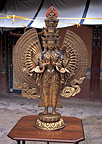
Item: Avalokiteshvara (Bodhisattva & Buddhist Deity) - Sahasrabhujalokeshvara (11 faces, 1000 Hands)
| Origin Location | Tibet |
|---|---|
| Date Range | 1800 - 1899 |
| Lineages | Buddhist |
| Material | Copper |
| Collection | Private |
| Catalogue # | Norbulingka Palace, Lhasa |
Alternate Names: Lokeshvara Avalokita Lokanata Lokanatha Mahakarunika
Classification: Deity
Appearance: Peaceful
Gender: Male
Avalokiteshvara, Sahasrabhuja Ekadasamukha (Tibetan: chen re zig, chag tong shal chu chig. English: the All Seeing Lord with 1000 Hands and 11 Faces).
The bodhisattva Avalokiteshvara is the patron deity of Tibet and appears in a variety of forms both peaceful, wrathful and in large mandalas surrounded by numerous deities. As a universal symbol he embodies the compassion of all buddhas of the ten directions and three times. In the standing form with 11 faces he is closely associated with the famous bhikshuni (nun) of Kashmir, Lakshmi (Tib.: Ani Palmo), who popularized a meditation practice incorporating a 2 day purification and fasting ritual. Lord Atisha, Rinchen Zangpo and others popularized this practice throughout Tibet.
History: At one time the bodhisattva Avalokiteshvara made a promise that should he give rise to thoughts of self benefit may the head break into 10 pieces and the body into 1000. After continuously witnessing the misery of beings in various states of existence, discouraged, he gave rise to thoughts of seeking only his own happiness. At that very instant the head and body shattered. Calling out to Amitabha, the buddha came forth and spoke words of encouragement. Gathering up the 10 pieces of the head Amitabha constructed 10 faces - representing the 10 perfections. Gathering the 1000 pieces of the body he constructed another with 1000 hands each with an eye on the palm - representing the 1000 buddhas of the Golden Aeon. Finally he placed a duplicate of his own head at the crown - illuminating the entire threefold universe.
Lineage: Avalokiteshvara, Bhikshuni Shri, Dawa Shonnu, Pandita Jnanabhadra, Balpopa Nyewa, Jangsem Dawa Gyaltsen, Nyi Phugpa Chokyi Dragpa, Pupa Dorje Gyalpo, Shangton Drajig, Chidul Tugje Jangchub, Khenchen Dechenpa, Chuzangpa Wangchug Bar, Sherab Bum, Gyalse Togme, Buddhashri, etc.
Jeff Watt 9-2000
Peaceful in appearance, with eleven faces rising upward in groups of three, the tenth is wrathful and the face at the top is that of the Buddha Amitabha. A thousand arms fan out at the sides and with the two legs together he stands atop a lotus flower. The All-seeing Lord is a meditational deity popular throughout Asia. The ten main heads represent the ten most important Buddhist virtues such as patience, morality, generosity and wisdom. The one thousand arms represent the one thousand Buddhas of this age. The All-seeing Lord is the patron deity of Tibet and the Dalai Lamas are believed to be his emanations. (Text courtesy of the Rubin Museum of Art).
Exhibition: Tibet, Treasures from the Roof of the World
Thematic Sets
Buddhist Deity: Avalokita (11 Faces) Sculpture Masterworks
Buddhist Deity: Avalokiteshvara (Eleven Faces)
